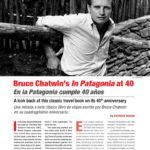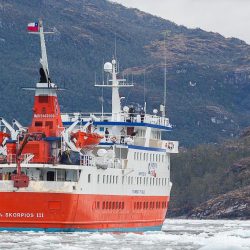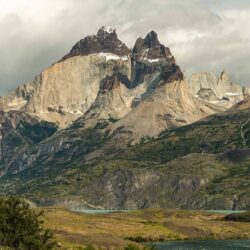Bruce Chatwin’s In Patagonia at 40
A look back at this classic travel book on its 40th anniversary.
In an essay about writing that he wrote for The New York Times in February 1983, Bruce Chatwin concludes with a brief story about how his first book came about. One afternoon, says Chatwin, he was visiting the architect and designer Eileen Gray at her apartment in Paris, when he noticed on the wall of her salon a map of Patagonia. ”I’ve always wanted to go there,” said Chatwin. ”So have I,” Gray responded. ”Go there for me.”
The seed was planted, and two years later, while in New York on assignment for The Sunday Times of London, on the spur of the moment he made the momentous decision to go for it. In a telegram to his editor, he wrote: “Ran away to South America/ I have been staying with a cousin in Lima for the past week and am going tonight to Buenos Aires. I intend to spend Christmas in the middle of Patagonia/ I am doing a story there for myself, something I have always wanted to write up.”
He had struck upon the idea for a book, and before flying to South America he briefly laid out the plan to a literary agent. The book, wrote Chatwin, would in part be a quest to find the origins of a piece of animal skin in his grandmother’s cabinet which she said was a “piece of brontosaurus” that her cousin, Charles Milward, sent to her from Punta Arenas, in Patagonia. But even more, Chatwin said the book would “be dictated by the journey itself. As it will be – to say the least – unpredictable, there is no point in even trying to guess what it will hold. I shall start the diary the moment I cross the Rio Negro.”
The result of his 4-month journey was In Patagonia, which was published in October 1977 with an initial print run of 4,000 copies. Forty years later, it has been translated into numerous languages, sold millions of copies, and to this day it remains the one must-read travel book about this part of the world. The book is a classic that has changed travel writing itself. It has also left a lasting impact on the Patagonia region, too. Through its collection of beautifully-written short tales of life in Chilean and Argentine Patagonia, it served as a sort of an introduction for the rest of the world to a mostly unfamiliar land.
In Patagonia
For its time, In Patagonia was experimental in its format. The 93 short chapters, some less than a page long, are loosely-related vignettes and visually descriptive snapshots of encounters the author had with a wide cast of characters. Chatwin was in hot pursuit of his grandmother’s piece of brontosaurus (which in reality turned out to be the remnants of an ancient giant sloth from Milodon’s Cave near Torres del Paine), but the journey proved more than fascinating, too.
According to Susannah Clapp, who edited In Patagonia and is author of With Chatwin: Portrait of a Writer, Chatwin described the book’s structure as “Cubist” – the art form pioneered by Pablo Picasso where objects are broken up and reassembled in an abstract form with subjects depicted from multiple viewpoints. Clapp worked with Chatwin for an entire summer reducing the final published book to a quarter of the original length of the manuscript. Speaking to the Patagon Journal, Clapp said that the book’s heterogeneous nature made it challenging to put together into some sort of homogeneous whole. “You didn’t have a reason to go from one page to another,” she said.
While far from being a guidebook, Chatwin did capture the essence of Patagonian culture with his precise descriptions of local traditions and inclusion of pieces of local history into the story. There were anecdotes about the escape to Patagonia and cattle rustling escapades of Butch Cassidy and the Sundance Kid, for example, or recounting the cultural upheaval in Chile when land was nationalized in 1973 and how the employees of land belonging to the daughter of a Scottish descendant turn on her after having looked after the farm for years.
Although Chatwin’s book concentrates on the interiors and people of Patagonia, he did come away impressed with Patagonia’s natural landscape. A month into his trip, he wrote to his wife: “In the east you suddenly confront the great wall of the cordillera with bright turquoise lakes with unbelievable colors to the rocks. Sometimes it seems that the Almighty has been playing at making Neapolitan ice-cream. Imagine climbing (as I did) a cliff face 2000 feet high alternatively striped vanilla, strawberry and pistachio in bands of 100 feet or more. Imagine an upland lake where the rock face on one side is bright purple, the other bright green, with cracked orange mud and a white rim. You have to be a geologist to appreciate it.”
Forty years after it was first published, the book’s vivid portrait of life in Patagonia is chiseled into the memories of its readers much like an unforgettable Rembrandt painting, or a Mozart symphony.
Write or call for availability:
tours@farsouthexpeditions.com
+56 61 261-5793





















